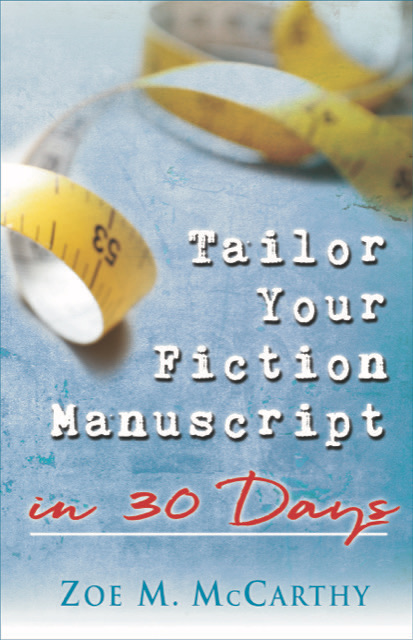Zoe’s book, Tailor Your Fiction Manuscript in 30 Days, is a fresh and innovative refocusing of your novel or novella. Through a few simple—and fun—steps, Zoe helps writers take their not-ready-for-publication and/or rejected manuscripts to a spit-polish finish. Writing is hard work, yes, but it doesn’t have to be difficult. —Eva Marie Everson, best-selling and multiple award-winning author, conference director, president of Word Weavers International, Inc.
See the end of this post for more information.
Stories have three places they begin: too early, too late, or just right. Starting in the right place is about deciding what’s the actual current story. Readers want to start in the action of what I’ll call the real story.
Too Early

The reason readers leave is the writer makes them plow through too much set-up drudgery. The reader is bored.
The writer starts somewhere in a character’s backstory so the reader will understand why the character is like she is. Then, to get to the real story, the writer wearies the reader with hours, days, or years of mundane events unrelated to the real story.
Too Late

The reason readers leave is the writer plunks the reader into a period after the most crucial real-story event has happened. The reader is confused, especially when the writer holds back information about the crucial event thinking this adds suspense.
The writer starts where the character is reacting strangely to situations. Not knowing anything about the crucial event, the reader may think the character is unlikeable—whiny or unreasonable.
The writer has placed the crucial event into the backstory. Instead of experiencing the event with the character, the reader now:
- has to read what a character thinks or dialogs about the event to be brought up to speed, or
- becomes confused about what’s going on, and
- has little buy-in to how the event affected the character and his goals.
Just Right

The reason the reader stays is the writer draws the reader into a journey with one event that challenges the character’s goals, causes him to make hard decisions, and forces him to take significant actions.
Look for the event, no matter how big or small, that upsets the character’s normal world. This event is called the inciting incident. The place to start the story is just before the inciting incident occurs—long enough to show what the character’s ordinary world is like. Then, bam, the event happens and triggers a change in the character and sends her on a journey.
An Example
Backstory: Austin’s dad left when he was seven. Today, he backs away from relationships when women talk about marriage and having children. He fears being a father like his dad.
Ordinary world: He’s a detective. He and his team chill at a pizza parlor after putting away a crooked art dealer. The guys tease Austin about taking two weeks off to hike in the Colorado Rockies to get away from his latest girlfriend.
 Inciting incident: Tired from the case, the men leave. Austin visits the restroom then heads to his SUV. As he opens the car door, a woman, Missy, jabs a gun into his ribs and takes possession of his Glock. She directs him to get inside, then she and her seven-year-old son Silas climb into the backseat. Holding her gun to his head, she tells him to drive out of Boulder going east. He tries to talk her out of kidnapping him. No go. He’s no longer the cop but the victim.
Inciting incident: Tired from the case, the men leave. Austin visits the restroom then heads to his SUV. As he opens the car door, a woman, Missy, jabs a gun into his ribs and takes possession of his Glock. She directs him to get inside, then she and her seven-year-old son Silas climb into the backseat. Holding her gun to his head, she tells him to drive out of Boulder going east. He tries to talk her out of kidnapping him. No go. He’s no longer the cop but the victim.
Journey: The real story unfolds. The three travel to Florida. The thugs Missy had been involved with are in hot pursuit. Austin learns Silas witnessed the thugs murdering Missy’s boyfriend. In the past, Austin arrested Missy and told her she should get her life straight. She’s taking him up on his advice. On the trip, Austin’s backstory is fed in a little at a time, showing why he acts indifferent to Silas at first. Then, against what he wants, he becomes attached to Silas. And the story goes on. (Only in some stories does the character leave on a literal journey.)
Starting too early: He’s in a relationship with Tracy. She starts talking about marriage. He share’s stories about what his life was like without a father. Night after night she nags and he backs away. Finally, he leaves her. He and his team work on the crooked art dealer’s case. They catch the guy. They go to a pizza parlor. (Reader engaged in the real story?)
Starting too late: The story opens with Austin, Missy, and Silas having lunch at a restaurant in Dodge City, Kansas. They don’t converse. Austin’s thoughts center around how he’s smarter than Missy, who thinks she’s in control. Her sob story about thugs after Silas has prevented him from hiking two weeks in the Rockies. But he’s a cop and will handle her. He wishes he’d never met Missy in the past. They leave the restaurant and continue driving toward Florida. (Reader thinks he’s on a job? Finds Austin whiny? Thinks missy is an old girlfriend?)
Where does your story start? What’s the inciting incident that sets your character on a journey?

I finished reading Tailor Your Fiction Manuscript in 30 Days. I have AND will highly recommend it to anyone who dabbles in fiction. It’s one of the best “how to” books I’ve ever read.
—Marsha Hubler, Director Montrose Christian Writers Conference
If you want to increase your chance of hearing yes instead of sorry or not a fit for our list at this time, this book is for you. If you want to develop stronger story plots with characters that are hard to put down, this book is for you. Through McCarthy’s checklists and helpful exercises and corresponding examples, you will learn how to raise the tension, hone your voice, and polish your manuscript. I need this book for my clients and the many conferees I meet at writer’s conferences around the country. Thank you, Zoe. A huge, #thumbsup, for Tailor Your Fiction Manuscript in 30 Days.
—Diana L. Flegal, literary agent, and freelance editor
Tailor Your Fiction Manuscript is a self-editing encyclopedia! Each chapter sets up the targeted technique, examples show what to look for in your manuscript, then proven actions are provided to take your writing to the next level. Whether you are a seasoned writer or a newbie, you need this book!
—Sally Shupe, freelance editor, aspiring author
Need to rework your book? Zoe M. McCarthy’s step-by-step reference guide leads you through the process, helping you fight feeling overwhelmed and wrangle your manuscript into publishable shape in 30 days. Tailor Your Manuscript delivers a clear and comprehensive action plan.
—Elizabeth Spann Craig, Twitteriffic owner, bestselling cozy mystery author of the “Myrtle Clover Mysteries,” the “Southern Quilting Mysteries,” and the “Memphis Barbeque Mysteries,” http://elizabethspanncraig.com/blog/
Zoe has developed a guiding resource for beginning writers. Her method is designed for brainstorming, shaping, and revising the early draft of a manuscript. General and specific tips are offered for applying rules of writing to enhance one’s story for a workable second draft. By exploring the plot line of Love Comes Softly, writers may examine their own work for stronger plot and characterization. Valuable tools are offered that enable the writer to develop a workable draft in only 30 days!
—Yvonne Lehman, award-winning, best-selling author of 48 novels
Tailor Your Fiction Manuscript in 30 Days is chock-full of practical techniques. Numerous examples clarify problem areas and provide workable solutions. The action steps and blah busters McCarthy suggests will help you improve every sentence, every paragraph of your novel. If you follow her advice and implement her strategies, a publisher will be much more likely to issue you a contract.
—Denise K. Loock, freelance editor, lightningeditingservices.com
A concise, detailed, step by step resource for all writers.
— Jamie West, editor coordinator, Pelican Book Group
Zoe’s writing blog has always intrigued me. As a high school English teacher, I can attest that her tips on good grammar and her hints for excellent sentence and paragraph structure are spot on. But as an author, I also appreciate her ever-present advice that excellent skills are not enough: you must tell a good story, too. This book clearly shows how to do it all.
—Tanya Hanson, “Writing the Trails to Tenderness,” author of Christmas Lights, Outlaw Heart, Hearts Crossing Ranch anthology, and coming in 2019, Tainted Lady, Heart of Hope, and Angel Heart. www.tanyahanson.com
McCarthy crafted an amazing self-help book that will strengthen any writer, whether new or seasoned, with guidance and self-evaluation tools.
–Erin Unger, author of Practicing Murder, releasing in 2019









 RSS - Posts
RSS - Posts